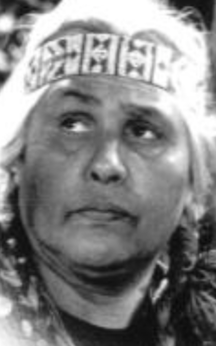Gertrude Chorre (April 30, 1885 – September 3, 1972) was an American film actress and talent scout based in southern California.
Early life
Gertrude Martinez was born in southern California, to Estefano Martinez (1824–1902) and Regina Guassac (1858–1905). She was an enrolled member of the La Jolla Band of Luiseno Indians,[1][2] and a fluent speaker of Luiseño.[3] The Guassac family was described as a "pioneering cattle raising family"; artist Fritz Scholder was her great-nephew.[4]
Career
Chorre appeared in films from the 1920s to the 1950s,[5] including credits in In Old California (1929) and Frozen Justice (1929).[6] She was often in small roles in Westerns,[7] including appearances in War Paint (1926), Western Frontier (1935),[8] The Outlaw Tamer (1935), Call of the Wild (1935), Lawless Riders (1935), Ramona (1936),[9][10] A Tenderfoot Goes West (1936), Rio Grande Ranger (1936), Join the Marines (1937),[11][12] Flaming Frontiers (1938),[13] Hawk of the Wilderness (1938), Murder on the Yukon (1940), Navajo Kid (1945),[13] The Sea of Grass (1947), We Were Strangers (1949), The Traveling Salesman (1950), Raw Edge (1956), and The First Traveling Saleslady (1956). On television she made an uncredited appearance in The Adventures of Rin Tin Tin (1958).
Chorre was said to be "a capable scout", rounding up other Native American actors for background work on Hollywood productions, sometimes with Jim Thorpe.[9] "Between them these two know the addresses of all the Indians hereabout who work from time to time in pictures," noted a 1936 report.[10] She sometimes worked with her children in films.[8][13][14] Late in life, she assisted French linguist André Malécot with language studies.[3] "She loved to regale you with stories of her people," he recalled. "She and her sister and a few others were the few who still spoke the language fluently back then."[15] She was also active in the American Indian Woman's Club in Los Angeles.[16]
Personal life
Gertrude Martinez married Andres Moro (or Morrow); her second husband was butcher Joseph C. Chorre (1890–1958), an alumnus of the Sherman Institute.[17] She had several children, including Marie (1919–1989), who appeared in White Fang (1936), Bennie, who appeared in Boys Town, and Joseph, known as "Sonny" (1914–1987), who was later known as wrestler Suni War Cloud.[13][14] Gertrude Chorre died in 1972, in Riverside, California, aged 87 years.[5][18] Her gravesite is in Woodlawn Memorial Cemetery in Santa Monica.
References
- ^ United States Congress Senate Committee on Indian Affairs (1934). Survey of Conditions of the Indians in the United States: Hearings Before a Subcommittee of the Committee on Indian Affairs. U.S. Government Printing Office. p. 16057.
- ^ Affairs, United States Congress Senate Committee on Indian (1934). Survey of Conditions of the Indians in the United States: Hearings Before a Subcommittee of the Committee on Indian Affairs, United States Senate, Seventieth Congress, Second Session[- Congress, Session] Pursuant to S Res. 79, a Resolution Directing the Committee on Indian Affairs of the United States Senate to Make a General Survey of the Condition of the Indians of the United States. U.S. Government Printing Office. p. 15976.
- ^ a b Storey, Pat (1995-09-15). "Novelist Returns to Temecula". The Californian. p. 21. Retrieved 2021-08-17 – via Newspapers.com.
- ^ "Isabelle M. Scholder, Member of Pioneer Family, is Dead at 84". Times-Advocate. 1965-04-12. p. 2. Retrieved 2021-08-17 – via Newspapers.com.
- ^ a b Berumen, Frank Javier Garcia (2020-11-20). American Indian Image Makers of Hollywood. McFarland. p. 45. ISBN 978-1-4766-7813-9.
- ^ Bernardine, Sue (1929-11-12). "Lenore Ulric's Talkie Drama Great Picture". The San Bernardino County Sun. p. 10. Retrieved 2021-08-17 – via Newspapers.com.
- ^ Raheja, Michelle H. (2010). Reservation reelism : redfacing, visual sovereignty, and representations of Native Americans in film. Lincoln: University of Nebraska Press. ISBN 978-0-8032-3445-1. OCLC 704517538.
- ^ a b "Eight Indian Tribes in Film". Kenosha News. 1936-11-13. p. 11. Retrieved 2021-08-17 – via Newspapers.com.
- ^ a b "Where Movies Gather Actors of Every Race". Dayton Daily News. 1936-05-26. p. 2. Retrieved 2021-08-17 – via Newspapers.com.
- ^ a b Henderson, Jessie (1936-05-17). "Gaunt Variety Scarce". The Baltimore Sun. p. 47. Retrieved 2021-08-17 – via Newspapers.com.
- ^ "Short Synopsis of Screen Showings Valley Theatres". The West Point News. 1937-02-04. p. 3. Retrieved 2021-08-17 – via Newspapers.com.
- ^ ATT (1937-02-15). "Daring 'Leatherneck' Overcomes All Odds to Capture Romance". The Evening Review. p. 6. Retrieved 2021-08-17 – via Newspapers.com.
- ^ a b c d "The Indians: Sonny Chorre, Gertrude Chorre". The Old Corral. Retrieved 2021-08-17.
- ^ a b "Joseph V. Chorre – a life in the movies". Valley Roadrunner. 2017-07-01. Retrieved 2021-08-17.
- ^ "Author: The Luiseno Culture (continued)". The Californian. 1995-09-15. p. 22. Retrieved 2021-08-17 – via Newspapers.com.
- ^ "West Ebell to Give Program Next Tuesday". The Los Angeles Times. 1928-03-04. p. 61. Retrieved 2021-08-17 – via Newspapers.com.
- ^ Merriam, C. Hart; Heizer, Robert F. (1898). C. Hart Merriam papers relating to work with California Indians, 1850-1974. (bulk 1898-1938). The Bancroft Library. p. 233 – via Internet Archive.
- ^ Stewart, William T. (1981). International film necrology. Internet Archive. New York : Garland Pub. p. 72. ISBN 978-0-8240-9552-9.

